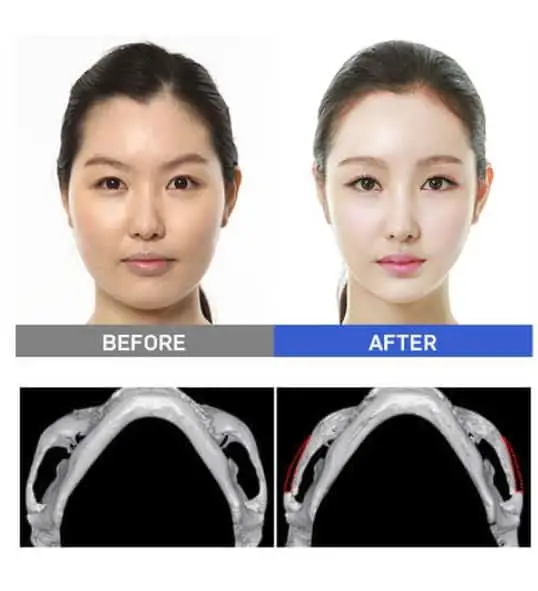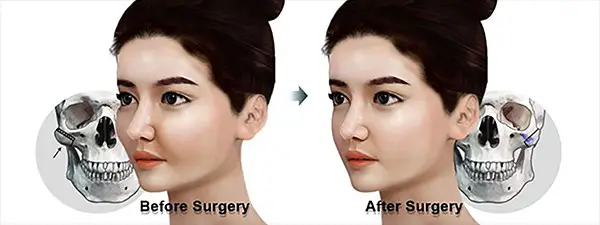
High cheekbones are a sought-after trait for many people. But some people want to reduce their high cheekbones to achieve a dainty and elegant appearance.
You can reduce the appearance of high cheekbones by getting dermal fillers or bone shaving surgeries. These methods can reshape the cheekbone, but reducing high cheekbones should not be your goal. What you’re most likely trying to do is reduce prominent cheekbones.
Your cheekbones are in the middle of your face and define your overall appearance. If your cheekbones are too prominent, your face can look bigger and too masculine.
Cheekbone Reduction Surgeries
Cheekbone reduction, also known as zygoma or malar reduction, is a type of surgery that can help you reduce the appearance of high cheekbones. Despite how it sounds, it does not flatten your cheekbone. Instead, cheekbone reduction reshapes your cheekbones to reduce facial width and give the face more depth.
There are several cheekbone reduction techniques that a surgeon may perform. Your surgeon may have you get an X-Ray to analyze your facial structure. It will also help your surgeon find out whether your high cheekbones are composed of excess fat, muscle, or bones, which will help them choose the best method.
The way your cheekbones protrude also helps your surgeon decide what technique is best for you. Some examples of cheekbone reduction techniques that you can get include these three main techniques:
- L-Shaped Osteotomy
- Malar Rotation Technique
- Scalp Approach Technique
These procedures usually take around 1 hour to complete. Most patients can have their stitches removed 7-10 days after the procedure. However, people with sensitive skin may need to wait a little longer to remove their stitches.
L-Shaped Osteotomy
L-Shaped Osteotomy is a common way to reduce the size of a prominent malar bone (Hong and Yang et al., 2017). This type of technique is for people whose cheekbones protrude to the front.

To perform this procedure, a surgeon creates a 2-cm incision on your mouth mucous membrane. Then, your surgeon will use a special saw to cut the cheekbone’s body to create an L-shape, hence the name. The surgeon will then use thread to suture the incisions shut once the procedures are complete.
Malar Rotation Technique
If your cheekbones protrude to the sides, then a surgeon may use this technique. Your surgeon will complete this procedure through a mesial-clockwise rotation of your zygomaticomaxillary complex (Choung et al., 2015).

This technique improves the bone contact, which reduces the volume of your cheekbones. Since this procedure makes your cheekbones protrude to the front, it will help you get a smaller and more defined face.
Scalp Approach
This method is for people whose cheekbones protrude both to the front and the sides of their faces. The technique is an excellent way to decrease the width of the face while adding more depth to it.

Your surgeon will create two incisions. One incision will be in your mouth membrane, whereas the other will be on your upper temple area where hair grows. Your surgeon will then use those incisions to see your exposed cheekbones and break them apart. Your surgeon will then push the broken piece inwards, then use a wire to fix it.
What Should I Expect After Cheekbone Reduction Surgery?
You may experience swelling, bruising, numbness, and pain around your cheeks during your initial healing phase.
You may occasionally feel tightness when you open your mouth. These are temporary symptoms that you may only have for 3-4 weeks.
Will I Get Scars After This?
Most patients will not get visible scars because many people can get the procedure done with an incision inside of their mouths.
For patients who get incisions in other places, like with the scalp approach, scars usually fade by themselves and typically vanish after 5-6 months.
Do I Need Follow-Up Procedures?
You may need to have follow-up appointments with your surgeon to monitor you. These appointments will help the doctor decide how the surgery went and if you need more work done.
In some cases, the incision in your mouth can aggravate a sagging face. Additionally, your cheeks may appear droopy since your cheekbones lost some volume. However, a surgeon can perform a facelift to lift your facial soft tissues to avoid you getting a sagging face.
Your doctor will also instruct you to follow postoperative care to get the best results from your procedure. Some examples of postoperative care include:
- No strenuous activity for around 3-4 weeks
- Adopting a soft diet for around 2-3 weeks
- If oral wounds are present, regularly rinse or use mouthwash after every meal.
- If there are external wounds present, using proper wound care
- Applying compressive dressing on the wound for around 3-5 days
- Taking prescribed medication as your doctor instructs
- Elevating your head for 3-4 weeks, especially when you are sleeping
Your doctor may give you analgesics to reduce the risk of postoperative pain. Your doctor might also prescribe antibiotics to reduce your risk of getting an infection.

What Are the Complications of Cheekbone Reduction Surgery?
With any procedure, it is always crucial that you understand every procedure has risks and complications.
While rare, primarily if the patient was carefully evaluated before a surgery and gets proper postoperative care, some risks may include:
- Asymmetry
- Bony contour irregularity
- Anesthesia risks
- Infection
- Blood clot
- Bleeding
- Temporary changes in skin sensation over your cheeks
- Injury to your surrounding bones, muscles, blood vessels and nerves
- Swelling and bruising around your eyes and cheeks
- The potential need for revision surgery
If cheekbone reduction surgery seems too invasive for you, then you can check out the next method to reduce high cheekbones.

Dermal Fillers
If you are looking for a less invasive procedure to reduce high cheekbones, then dermal fillers might be the way to go. However, this may be better for people who want to get a more youthful look and reduce the appearance of prominent cheekbones and cheek hollows.
If you have high cheekbones and massive cheeks, this may not be ideal for you. Fillers can’t remove volume, they can only fill it in. Dermal fillers add structure to the face and smooth out wrinkles and fine lines.
Most dermal fillers use gel made out of hyaluronic acid, which is naturally found in the body (Burdick and Stevens et al., 2005). The gel is a naturally soft substance, which makes it excellent to use for adding volume to the cheeks without creating a harsh look. You can have the fillers dissolved if you are not happy with the results.
The surgeon often administers this procedure under local anesthesia. Your surgeon may also apply pain-relieving ointment. Most patients only feel a slight sting from the procedure. A surgeon will use a very fine needle to inject small volumes of hyaluronic acid under the skin. This will add volume to your skin and reduce the appearance of cheek hollows and high cheekbones.
The procedure usually only takes 30 minutes. However, you may have to wait for 20-30 more minutes if your surgeon applied anti-pain ointment because you have to wait for it to wear off first.
Dermal fillers are temporary since most dermal fillers last for around 12-14 months. However, their longevity also depends on how fast your body breaks the substance down.

Can I Naturally Reduce High Cheekbones?
Unfortunately, there is no proven way you can naturally reduce the appearance of high and prominent cheekbones. There is also no known way to naturally lower your cheekbones. More invasive methods are required.
The most effective way to reduce high cheekbones is by getting cheek reduction surgery to reshape them. However, dermal fillers are a less invasive method that you can try to try for blending in your cheekbones with your lower cheek.

